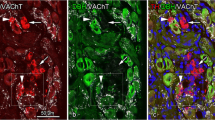Summary
The pineal gland of the rat is located near the brain surface and is via a slender stalk connected to lamina intercalaris which constitutes a cell formation between the habenular and posterior commissures, continuing to the subcommissural organ. The stalk and lamina intercalaris, like the pineal proper, exhibited a yellow, formaldehyde-induced fluorescence which showed the histochemical and pharmacological properties of 5-HT. All these structures were richly supplied with catecholamine-fluorescent nerves which could be further followed rostrally from lamina intercalaris, mixing with the non-fluorescent commissural fibres and stria terminalis, into the medial habenular nucleus in which they extensively supplied both blood vessels and non-fluorescent nerve cells. Cytospectrofluorometric and chemical analysis suggested that the fluorescent nerves stored noradrenaline. This was supported by the finding that they disappeared after bilateral cervical sympathectomy (as did the fluorescent nerves in the pineal complex). In the medial habenular nucleus also catecholamine-containing and 5-HT-containing nerves of central origin were present.
The occurrence of a rich, peripheral sympathetic innervation in the medial habenular nucleus of the brain offers possibilities for a previously not observed sympathetic influence on this nucleus. Also the arrangement, and the apparent continuity of the sympathetic innervation in the pineal gland, the lamina intercalaris, and the medial habenular nucleus, suggests some functional interconnection or coordination between these structures.
Similar content being viewed by others
References
Ariëns Kappers, J.: The development, topographical relations and innervation of the epiphysis cerebri in the albino rat. Z. Zellforsch. 52, 163–215 (1960).
Bertler, Å., Carlsson, A., Rosengren, E.: A method for the fluorimetric determination of adrenaline and noradrenaline in tissues. Acta physiol. scand. 44, 273–292 (1958).
— Falck, B., Owman, Ch.: Studies on 5-hydroxytryptamine stores in pineal gland of rat. Acta physiol. scand. 63, Suppl. 239, 1–18 (1964).
Björklund, A.: Monoamine-containing fibres in the pituitary neuro-intermediate lobe of the pig and rat. Z. Zellforsch. 89, 573–589 (1968).
— Ehinger, B., Falck, B.: A method for differentiating dopamine from noradrenaline in tissue sections by microscopectrofluorometry. J. Histochem. Cytochem. 16, 263–270 (1968).
— Falck, B., Owman, Ch.: Fluorescence microscopic and microspectrofluorometric techniques for the cellular localization and characterization of biogenic amines. In: S. A. Berson (ed.), Methods of investigative and diagnostic endocrinology, vol. 1, J. E. Rall and I. J. Kopin (eds.), The thyroid and catecholamines. Amsterdam: North Holland Publishing Company 1972.
— Owman, Ch., West, K. A.: Discussion. In: G.E. W. Wolstenholme and J. Knight (eds.), The pineal gland. A Ciba Foundation Symposium, p. 29. Edinburg-London: Churchill Livingstone 1971.
Carlsson, A.: Drugs which block the storage of 5-hydroxytryptamine and related amines. In: V. Erspamer (ed.), Handbook of experimental pharmacology, vol. 19, 5-Hydroxytryptamine and related indolealkylamines, p. 529–592. Berlin-Heidelberg-New York: Springer 1966.
Falck, B., Mchedlishvili, G. I., Owman, Ch.: Histochemical demonstration of adrenergic nerves in cortex-pia of rabbit. Acta pharmacol. (Kbh.) 23, 133–142 (1965).
— Owman, Ch.: A detailed methodological description of the fluorescence method for the cellular demonstration of biogenic monoamines. Acta Univ. Lund. II 7, 1–23 (1965).
Fuxe, K.: Evidence for the existence of monoamine neurons in the central nervous system. IV. Distribution of monoamine nerve terminals in the central nervous system. Acta physiol. scand. 64, Suppl. 247, 37–85 (1965).
Häggendahl, J.: An improved method for fluorimetric determination of small amounts of adrenaline and noradrenaline in plasma and tissues. Acta physiol. scand. 59, 242–254 (1963).
Herbert, J.: The role of the pineal gland in the control by light of the reproductive cycle of the ferret. In: G. E. W. Wolstenholme and J. Knight (eds.), The pineal gland. A Ciba Foundation Symposium, p. 303–320. Edinburgh-London: Churchill Livingstone 1971.
Nielsen, K. C., Owman, Ch.: Contractile response and amine receptor mechanisms in isolated middle cerebral artery of the cat. Brain Res. 27, 33–42 (1971).
Owman, Ch.: Secretory activity of the fetal pineal gland of the rat. Acta morph. neerl.-scand. 3, 367–394 (1961).
— Sympathetic nerves probably storing two types of monoamines in the rat pineal gland. Int. J. Neuropharmacol. 3, 105–112 (1964).
— Localization of neuronal and parenchymal monoamines under normal and experimental conditions in the mammalian pineal gland. Progr. Brain Res. 10, 423–453 (1965).
Quay, W. B.: Volumetric and cytologic variation in the pineal body of Peromyscus leucopus (Rodentia) with respect to sex, captivity and day-length. J. Morph. 98, 471–495 (1956).
Sheridan, M. N., Reiter, R. J.: Observations on the pineal system in the hamster. I. Relations of the superficial and deep pineal to the hypothalamus. J. Morph. 131, 153–162 (1970a).
— Observation on the pineal system in the hamster. II. Fine structure of the deep pineal. J. Morph. 131, 163–178 (1970b).
Trueman, T., Herbert, J.: Monoamines and acetyl-cholinesterase in the pineal gland and habenula of the ferret. Z. Zellforsch. 109, 83–100 (1970).
Wolfe, D. E.: The epiphyseal cell: an electron-microscopic study of its intercellular relationships and intracellular morphology in the pineal body of the albino rat. Progr. Brain Res. 10, 332–376 (1965).
Wurtman, R. J., Axelrod, J., Kelly, D. E.: The pineal. New York-London: Academic Press 1968.
Author information
Authors and Affiliations
Rights and permissions
About this article
Cite this article
Björklund, A., Owman, C. & West, K.A. Peripheral sympathetic innervation and serotonin cells in the habenular region of the rat brain. Z.Zellforsch 127, 570–579 (1972). https://doi.org/10.1007/BF00306872
Received:
Issue Date:
DOI: https://doi.org/10.1007/BF00306872




